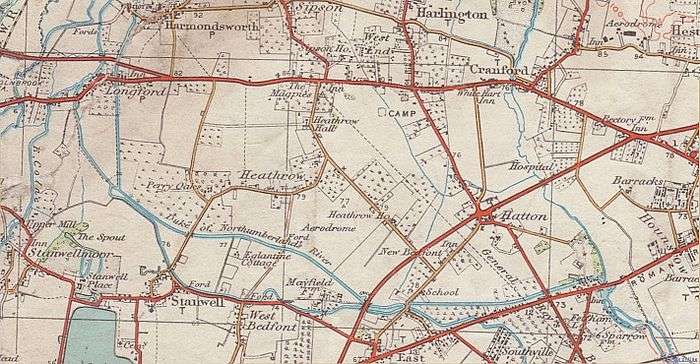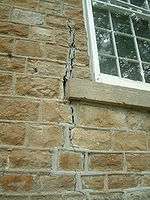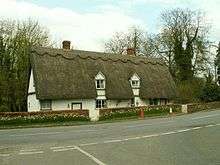Chartered Surveyor
Chartered Surveyor is the description (protected by law in many countries) of Professional Members and Fellows of the Royal Institution of Chartered Surveyors (RICS) entitled to use the designation (and a number of variations such as "Chartered Building Surveyor" or "Chartered Quantity Surveyor" or "Chartered Civil Engineering Surveyor" depending on their field of expertise) in Commonwealth countries and Ireland. Chartered originates from the Royal Charter granted to the world's first professional body of surveyors. Chartered Surveyors are entitled to use "MRICS" or "FRICS" after their names as appropriate.
Chartered Surveyors are highly trained and experienced property professionals. Surveyors offer impartial, specialist advice on a variety of property related issues and the services which they provide are diverse.[1]
Chartered Surveyors work in all fields of property and building consultancy. At the most basic level, their duties include valuing property and undertaking structural surveys of buildings. They also provide expert consultancy advice in property, construction and related environmental issues.
United Kingdom
A Chartered surveyor in the United Kingdom is a surveyor who is a member of the Royal Institution of Chartered Surveyors ("RICS"). Until the end of the 20th century, some members were members of the ISVA ("Incorporated Society of Valuers and Auctioneers"), but this organisation merged into the RICS in 1999.[2]
In the reforms of the RICS in the 1990s, the former divisional structure of the institution was abolished and the use of the alternative designations retained solely for the use of members to retain clarification when informing clients of specialist areas of expertise. Despite the attempt to unify the profession under one title chartered surveyor there is very little in common across the whole range of disciplines that are within the grasp of all members. The core membership is based in the construction profession, and another large sector deal with property ownership and management. Beyond these cores there are marine, land, rural and antiques specialists.
Chartered surveyors in the core of the profession may offer mortgage valuations, homebuyer's survey and valuations, full building surveys, building surveyors' services, quantity surveying, land surveying, auctioneering, estate management and other forms of survey and building-related advice. It is not usual for an individual member to have expertise in several areas, and hence partnerships or companies are established to create general practices able to offer a wider spectrum of surveying services.

Real Estate Valuation in the UK
The common public experience of chartered surveyors is in the process of obtaining a mortgage loan.[3] A mortgage valuation will be required by any mortgage lender as a condition of obtaining a mortgage loan. The homebuyer may take the option to instruct the same surveyor to carry out a "RICS HomeBuyer Report" or a "RICS Building Survey" (sometimes called a "Structural Survey"[4]), usually at additional cost.[3] When the surveyor is instructed in this combined role, the mortgage valuation is still produced for the lender, and the HomeBuyer Report or Building Survey is additionally prepared for the borrower. This arrangement can avoid the potential conflict of interest where the surveyor has as client both the lender and the borrower in the transaction. Because of the ethics and professional liability aspect, borrowers should note that the lender's survey is produced solely for the lender and the surveyor will not be liable for loss or omission to the borrower. Since reform of the RICS Red Book of valuation practice in recent years, the definition of a mortgage valuation has been deleted. It is now a market valuation which is the same definition given to the valuation in the RICS HomeBuyer Report.
The Council of Mortgage Lenders recommends that buyers should not rely only on the mortgage valuation, but obtain a fuller survey for their own purposes. Various mortgage-related sources endorse this advice.[5] However, a fuller survey is rarely a condition of the loan.[6]

The borrower may prefer to select an independent surveyor to undertake the HomeBuyer Report or Building Survey.[7]
Mortgage valuation report
A mortgage valuation is for the benefit of the lender. Its purpose is merely to confirm the property is worth the price paid, in order to protect the lender's interests.[8] Invariably there is a disclaimer on the report that confirms that the surveyor has no responsibility to the borrower. This is a legally valid exclusion.
RICS Home Surveys
Under the reforms undertaken by RICS in the early 21st century to better regulate the provision of professional products to the general public, a sector that is usually unable to fully appreciate the consequences of inadequate specification of the required items to be surveyed and how they are reported, RICS produced a new range of consumer products with RICS branding. Three consumer products are now available - 1. RICS Condition Report 2. RICS HomeBuyer Report 3. RICS Building Survey These products have a consistent appearance over the range, with common typefaces and general format. The distinctions come in the detail that is subsequently provided. These are discussed below.
RICS Condition Report
This is short report that looks briefly at the property to report on the visual condition of nine external elements of construction, nine internal elements of construction, seven services supplied to the building, and three key components of the grounds in which the property is sited. The reports rates conditions from 1 - good, 2, - needing attention in the near future, 3 - needing attention now using a traffic light system to draw attention to things that matter.
In practice this report is of little value to the buyer unless the surveyor attends at the same time as the buyer is carrying out a viewing and wants an early indication of general condition, making the most of the surveyor's expert knowledge about how buildings can fail that are not obvious to the average buyer. Some surveyors agree to carry out these surveys as a precursor to then extending the service with a more detailed report in either of the other two types in the RICS Home Surveys suite.[9] Usually, the fee for the first report is discounted in the fee for the detailed follow up report, since when the surveyor returns to the property, there is already an understanding of what problems are in the property.
RICS HomeBuyer Report
This document format has been revised in 2010 to include an easy to assimilate format for the reader. The problem with the earlier format often reported to RICS by clients in receipt of the previous 'Homebuyer's Survey and Valuation' was that the structure did not easily distinguish the faults from the main description. A traffic light system was introduced and surveyors have to rate each element of the inspection according to priority. In this way, serious impediments are identified easily, and less critical defects commented upon to give the reader advice on what will need attention in the near future. It does not comment on the maintenance requirements for items found to be in satisfactory condition, only confirming that there is no cause for concern at this time. This format is suitable for a wide range of properties, but is best suited to traditionally built houses that are not subject to very serious distress or previous major alterations or extensions. This report is much longer than the condition report and looks in more detail at the property to report on the visual condition and maintenance needs of nine external elements of construction, nine internal elements of construction, seven services supplied to the building, and three key components of the grounds in which the property is sited. The reports rates conditions from 1 - good, 2, - needing attention in the near future, 3 - needing attention now using a traffic light system to draw attention to things that matter. The report also includes commentary to advise your solicitor on issues that need addressing in the conveyance, and any risks that affect the building, grounds and people of a more general nature. There is also a market valuation of the property and an assessment of rebuilding costs for insurance purposes.
Not all chartered surveyors are permitted to undertake providing the RICS HomeBuyer Report as it contains a market valuation. Under rules of the Royal Institution of Chartered Surveyors, any surveyor undertaking these surveys must also be an RICS Registered Valuer and carry professional indemnity insurance for this task. This is an attempt by RICS to provide consumer confidence after the older valuation reports came into disrepute.
RICS Building Survey

There are a number of variations to a residential building survey which offers the home purchaser a choice of products. The two main variants are the RICS Guidance note version stemming from the earlier RICS guidance note 2004 (more recently updated by the "Surveys of residential property RICS guidance note 3rd edition" which was introduced in December 2013). The primary difference between guidance note and the practice note for the consumer is the format of the reports. A bespoke style or a framework (traffic light signal) style. For surveyors guidance is "best practice" and practice note is "mandatory".
The guidance note version can be provided in an agreed word document style format with an appendix for photographs etc. There is also a choice (at extra commissioning cost) to add a market valuation and other services such as costing for repairs and project management / further investigation services by agreement as cited at the end of this description. In effect, is a fully bespoke report.
The alternative is the practice note version (introduced to the market in November 2012). It is a similar traffic light signal format as the other RICS survey products such as the RICS condition report and the RICS homebuyer reports.
Both report formats (guidance note and practice note versions) are appropriate for virtually all properties, including but not limited to listed buildings, thatched cottages, timber frame homes and so on,.[10]
The building survey is the most detailed survey available [11] from most firms of Chartered Surveyors.[8] Thorough though it is, it may still lead to recommendations for further investigation from other specialists; see below. The building survey report is much longer than the condition report but may not be much longer than the homebuyer report as its content depends on the condition observed in each individual case. The practice note version building survey looks in more detail at the property to report on the visual condition and maintenance needs of nine external elements of construction, with scope for sub-division into individual features, with the nine internal elements of construction and the seven services supplied to the building examined in a similar manner. Also the three key components of the grounds in which the property is sited can be subdivided as necessary.
The practice note version of the report also rates conditions from 1 - good, 2, - needing attention in the near future, 3 - needing attention now using a traffic light system to draw attention to things that matter. In this format, if there is a defect, not only will it be identified but its causes analyzed and methods of repair and elimination of the cause discussed in some detail. The report also includes commentary to advise your solicitor on issues that need addressing in the conveyance, and any risks that affect the building, grounds and people of a more general nature. There is also discussion on the means of escape in case of fire, which in older houses in particular can be compromised by poor design and alterations. There is no market valuation or an assessment of rebuilding costs for insurance purposes in the document. These can be added, along with cost estimates for the repairs by a separate agreement as discussed in the helpful RICS explanatory notes to clients.
Collectively, a key feature of RICS building surveys are that they provide an opportunity for clients and surveyors to strike up a detailed dialogue about the property they are intending to purchase. Purchasers find a building survey useful in allowing for further negotiations on price or for providing a clients briefing document for extensions or repairs. The building survey is a very interactive process.
Energy performance certificate
Chartered surveyors can also provide an energy performance certificate.[12]
Limits
Chartered Surveyors are not necessarily specialists in other fields, and may recommend further investigations by an electrician, a gas engineer, a structural engineer or expert of another kind, depending on what they find during their inspection. They may also recommend work by the buyer's solicitor to confirm matters which might affect their valuation, such as (with leasehold properties), the unexpired term of the lease, who is responsible for the boundaries, and so forth.
The Chartered Surveyor's inspection is typically non-intrusive. They do not have the authority to lift floorboards, drill holes, or perform excavations at a property which the prospective buyer does not, at this stage, own, which means that certain defects or problems may not be apparent from their inspection.[13]
Their fees are a component of the Cost of moving house in the United Kingdom.
Building surveying
As well as surveying, building surveyors in the UK give advice on design, construction, maintenance and repair.[14] They may also assess damage or dilapidations on behalf of an insurance company.
Fully qualified building surveyors in the UK are frequently, but not always members of the RICS.
Quantity surveying
Quantity surveyors work for private and commercial clients, main contractors and subcontractors in the construction industry. Their function is management of the commercial interfaces of construction: writing, negotiating, awarding and administering contracts, including variations and claims arising during the performance of a contract; cost control and cost engineering,[15] i.e. to document and estimate costs, progress, and risks. In the UK, not all quantity surveyors are necessarily chartered surveyors; some may be chartered through the Chartered Institute of Building ("CIOB").[16] Albeit, the title of 'Chartered Quantity Surveyor' can only be used by Members of the Royal Institution of Chartered Surveyors.
Additional duties may include performing feasibility studies, preparing tenders, procuring materials, managing subcontractors, and even advice on taxation or building management.[17] Surveyors may also be involved in dispute resolution.[18]
Quantity surveyors sometimes act as project managers of a construction site.[16]
Land surveying
Essentially, land surveying is making accurate maps and plans.[19] Land surveying encompasses cadastral surveying, cartography, engineering surveying, hydrographic surveying and oceanographic surveying.[19] Land surveyors may be accredited by the RICS, Chartered Institute of Building (CIOB), or the Institution of Civil Engineering Surveyors (ICES),[19] but only RICS members can call themselves "chartered land surveyors".
Auctioneering
Firms of chartered surveyors sometimes act in property auctions.[20]
Other aspects of surveying practice
As well as the services mentioned above, UK chartered surveyors may offer advice in boundary disputes, business rates, compulsory purchase matters and party walls.[21] ("Party walls" in the UK are walls on your property shared with your neighbours.)
Employers
The largest employer of Chartered Surveyors is Turner & Townsend.[22]
Notable Chartered Surveyors
- Andy Irvine - retired rugby union footballer who played for Scotland is a Chartered Valuation Surveyor.[26][27]
- Gavin Kerr - retired rugby union footballer who played prop for Scotland is a Chartered Building Surveyor.[28]
- Paul Morrell - a Chartered Quantity Surveyor.[29]
- Tim Wonnacott is a Chartered Valuation Surveyor[30] and television presenter.
- Marianne Suhr - writer, expert on historic buildings and co-presenter of the television series Restoration is a Chartered Building Surveyor.[31]
- Ewen Cameron, Baron Cameron of Dillington - a landowner and life peer who sits as a crossbench member of the House of Lords.
- Philip Serrell - Television presenter, chartered valuation surveyor[32] and racing driver.
See also
| Look up survey in Wiktionary, the free dictionary. |
- Australian Property Institute, a similar professional body which has a reciprocity agreement with RICS
- Construction Industry Council
- RICS
- Chartered surveyors in the United Kingdom
References
- Benedictus, Leo (26 September 2009). "The chartered surveyor: Made to measure". The Guardian. Retrieved 28 September 2013.
- Property Week
- Royal Institution of Chartered Surveyors Archived November 17, 2007, at the Wayback Machine
- Shire Direct.com Archived 2008-07-24 at the Wayback Machine's mortgage glossary
- e.g. thisismoney.co.uk
- ourproperty.co.uk
- The HomeBuyer.org
- Council of Mortgage Lenders
- home.co.uk's home buying guide
- SDL Surveying (webpage)
- Compare My Move guide to EPC(webpage)
- Northern Rock Archived February 28, 2009, at the Wayback Machine
- Government careers advice Archived February 10, 2009, at the Wayback Machine site
- Icoste
- Salford University
- Prospects website Archived March 30, 2009, at the Wayback Machine
- Government careers advice Archived February 10, 2009, at the Wayback Machine site
- Our property website
- RICS Archived March 16, 2009, at the Wayback Machine
- RICS website Archived March 2, 2009, at the Wayback Machine
- "Top 50 Surveyors". Building. Retrieved 28 September 2018.
- Ford, Liz (1 December 2007). "So you want to work in ... Building surveyancy". The Guardian. Retrieved 28 September 2013.
- Bassey, Amardeep (25 February 2001). "SURVEYOR SNOBS IN UNI WRANGLE". Sunday Mercury. Retrieved 28 September 2013.
- "Degree without license". Times Educational Supplement. 19 January 1998. Retrieved 28 September 2013.
- "Find a member: Andy Irvine". Royal Institution of Chartered Surveyors. Retrieved 28 September 2013.
- "Commercial Property Services in Edinburgh". Jones Lang LaSalle. Archived from the original on 22 June 2013. Retrieved 28 September 2013.
- Dunton, Jim (23 May 2013). "Former Scots rugby star swaps scrum for surveying". Building. Retrieved 28 September 2013.
- "Find a member:Paul Morrell". Royal Institution of Chartered Surveyors. Retrieved 28 September 2013.
- "Find a member:Tim Wonnacott". Royal Institution of Chartered Surveyors. Retrieved 28 September 2013.
- "Find a member:Marianne Suhr". Royal Institution of Chartered Surveyors. Retrieved 28 September 2013.
- "Find a member:Philip Serrell". Royal Institution of Chartered Surveyors. Archived from the original on 26 February 2015. Retrieved 28 September 2013.